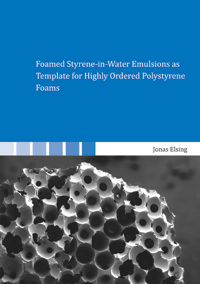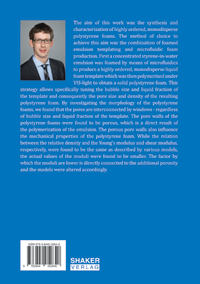
Shop : Details
Shop
Details
45,80 €ISBN 978-3-8440-5264-0Softcover140 pages80 figures195 g21 x 14,8 cmEnglishThesis
June 2017
Jonas Elsing
Foamed Styrene-in-Water Emulsions as Template for Highly Ordered Polystyrene Foams
The aim of this work was the synthesis and characterization of highly ordered, monodisperse polystyrene foams. The method of choice to achieve this aim was the combination of foamed emulsion templating and microfluidic foam production. First a concentrated styrene-in-water emulsion was foamed by means of microfluidics to produce a highly ordered, monodisperse liquid foam template which was then polymerized under VIS-light to obtain a solid polystyrene foam. This strategy allows specifically tuning the bubble size and liquid fraction of the template and consequently the pore size and density of the resulting polystyrene foam. By investigating the morphology of the polystyrene foams, we found that the pores are interconnected by windows - regardless of bubble size and liquid fraction of the template. The pore walls of the polystyrene foams were found to be porous, which is a direct result of the polymerization of the emulsion. The porous pore walls also influence the mechanical properties of the polystyrene foam. While the relation between the relative density and the Young's modulus and shear modulus, respectively, were found to be the same as described by various models, the actual values of the moduli were found to be smaller. The factor by which the moduli are lower is directly connected to the additional porosity and the models were altered accordingly.
Keywords: foam templating; microfluidics; polystyrene foams; monodisperse; polymer foams
Available online documents for this title
You need Adobe Reader, to view these files. Here you will find a little help and information for downloading the PDF files.
Please note that the online documents cannot be printed or edited.
Please also see further information at: Help and Information.
Please also see further information at: Help and Information.
| Document |  | Document | ||
| Type |  | |||
| Costs |  | 34,35 € | ||
| Action |  | Purchase in obligation and download the file | ||
| Document |  | Table of contents | ||
| Type |  | |||
| Costs |  | free | ||
| Action |  | Download the file | ||
User settings for registered online customers (online documents)
You can change your address details here and access documents you have already ordered.
User
Not logged in
Export of bibliographic data
Shaker Verlag GmbH
Am Langen Graben 15a
52353 Düren
Germany
Am Langen Graben 15a
52353 Düren
Germany
Mon. - Thurs. 8:00 a.m. to 4:00 p.m.
Fri. 8:00 a.m. to 3:00 p.m.
Fri. 8:00 a.m. to 3:00 p.m.
Contact us. We will be happy to help you.



